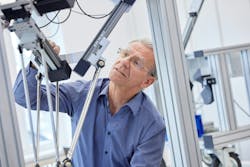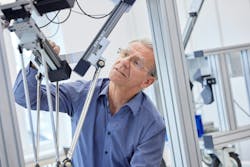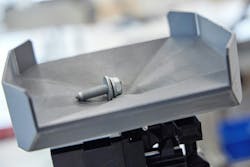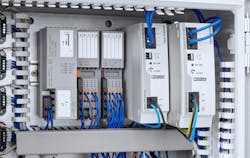Low-Cost Automation: Explore New Paths Via Magnetism and Gravity
Automation and robotics have been an integral part of industrial production for many years. As modern industrial robotics become more powerful and precise, products can now be manufactured with consistently high quality. However, there are still numerous manual, often-monotonous and physically stressful tasks that could not be automated economically until now.
These tasks usually involve work steps whose challenge does not so much lie in precise positioning, but in picking up undefined, recumbent workpieces. This is especially true with bulk goods. The effort required to deliver small and relatively light parts—such as screws and pressed parts—in a defined position is out of proportion to the actual material value. Therefore, they often arrive at the production lines unsorted in boxes.
Berlin-based Sikora GmbH has taken on these challenges and found new ways to automate the respective tasks through smart engineering. Founded in 1999, the company has been instrumental in shaping laser welding and soldering in the automotive industry. For example, the first laser-soldered tailgate was realized with Sikora GmbH components in the production facilities of a major automobile manufacturer.
After 20 years in this business, the company has realigned itself. The many years of experience in robot programming were used to develop a proprietary robot controller. With the SRS (Sikora Robot Controller), robot movements can be programmed easily. The first series use of the controller was realized in an application that “reaches into the box.”
READ MORE: Cognex Displays Vision Technology That Automate Quality Control Tasks in a Cinch
The solution for positioning bulk goods does not involve supplementing classic automation concepts with optical recognition systems that detect the position of the undefined supplied parts. “We use simple physical methods such as magnetism and gravity, which have often been forgotten in the face of all the high-tech,” says Ralf Sikora, general manager of Sikora GmbH. “With this approach, we do not need high-precision robotics or special drives and components. We call this low-cost automation, because simple and inexpensive parts are sufficient for our systems, which are often used in the laboratories of schools and universities.”
The result is impressive: In addition to low costs, the systems from Sikora GmbH are characterized by energy-saving operations. Here, the art of engineering is often evident in the details. Many system components are proprietary designs from the company’s own 3D printers. This approach makes it possible to balance individual system elements with demand. They require less drive power, which reduces energy requirements and results in less waste heat from the system. It also optimizes mechanical wear and increases the service life.
Transparent Processes, Fast Learning, Easy Operation
One positive side benefit is noticeable in the operation and maintenance of the Sikora systems: The process sequence is largely self-explanatory. Simply observing the applications is enough to understand how they work. This is valuable when there is a shortage of skilled workers. Transparent processes and the use of simple technology and drive components streamline the work of the maintenance team.
In the event of a malfunction, the Sikora systems can continue with limited operation—the so-called emergency strategy. At the same time, troubleshooting can be initiated. Once the cause of the fault has been identified, it can usually be rectified quickly, because it does not require software-intensive configuration.
READ MORE: Industrial Robots: Remote Monitoring and Control Solution Boosts Productivity
The system’s easy handling is also evident in the interfaces between the user and the controller. To operate and program the robots, Sikora engineers not only programmed their own robot controller, but also developed a haptic interface for it. What sounds complicated turns out to be simple in application.
A small robot, on a scale of about 1:10, is used for this. The user manually moves the axes in the way the robot is programmed to behave; it does not get more intuitive than that. A small two-line display and some mini-buttons complete the unit and, in this constellation, enable the robot to be taught. The mini-robot is produced via 3D printer, while the other components—such as the display and buttons—can be procured at low cost.
IT and OT on the Same Hardware
The robot controller is developed in the C++ programming language on small commercially available, Linux-based computers. However, appropriate hardware is required for use in harsh industrial environments. Sikora GmbH customers use standard control technology with well-known industrial protocols, such as Profinet and Profisafe. If the same control technology is used, the Sikora systems can be integrated easily into the customer's communication structure, but the robot controller, designed in C++, would not be able to run on it.
In his search for a solution to this challenge, Ralf Sikora came across PLCnext Technology from Phoenix Contact. The controllers of this open ecosystem meet all requirements for industrial use. In addition to the transmission protocols listed, these requirements include real-time capability and data consistency. The PLCnext Controls also enable the use of high-level language programs such as C++, C# and Python.
READ MORE: Driving Robotics and Embedded Motion Applications with Next-Generation Servo Technology
“The PLCnext Controls were the ideal basis for our system technology from the very beginning. This puts us way ahead of the usual PLC systems used in industry,” stated Ralf Sikora. “In addition to meeting all the demands of both our technology and our customers, PLCnext Technology offers the best conditions for future requirements.”
Increasing digitalization results in the increased networking of OT and IT systems, making IT security much more important than before. PLCnext Technology meets all of the IEC 62443 standards for IT security in automation. In addition, just as it is now possible to carry out sensitive banking transactions on a smartphone in a public WLAN, PLCnext Technology relieves users of the worry of facing attacks from the network without protection or transmitting sensitive data unsecured.
Intuitive Operation by the User
Sikora's automation solution is easy for automation engineers used to working with classic control technology. At the same time, the fast-growing number of users from the IT sector appreciate PLCnext Technology. The open ecosystem supports all of their requirements, including high-level language applications, database connections, cloud communication, artificial intelligence and apps. This goes beyond the limits of classic control technology.
When solving industrial tasks, the question used to be what was technically possible. Today, the question is which options users want to take advantage of. Simplicity has always been an advantage; the success of smartphones is largely due to how intuitive they are to use. However, users do not notice the complex technology inside the phones that makes them work. The easy-to-understand user interface is what matters to most people.
The situation is similar in automation. Operators and maintenance personnel need a simple system, enabling them to perform quick and trouble-free commissioning and maintenance. This increases the availability of the application. IT provides many solutions that are easily available due to open source. This makes it easier to use the user interfaces of the apps installed on a smartphone or tablet.
Conclusion
Industrial control technology, which also enables the use of smartphone-like solutions in the automation environment, will lead to a comparable development dynamic in the industry. Ralf Sikora is certain: “The good ideas have long been there. The only thing missing so far is the ability to apply them in the OT world. PLCnext Technology has now opened up this path for us, and our customers are amazed at what can be achieved. And I am sure a lot more will happen in the future.”






